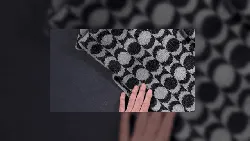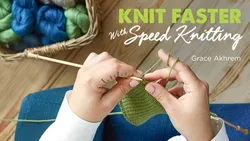
Introduction to Stranded Knitting 
This course from Interweave unlocks the secrets of stranded knitting, teaching you the basics of colorwork with designer, author and instructor Kyle Kunnecke. You'll learn about color theory, including tips for choosing the best color combos, the basic techniques for stranded knitting, how to read charts, and an overview of locked floats. With this course, you'll be able to confidently create beautiful stranded knitting projects with no loose strands on the back of your fabric. ▼
ADVERTISEMENT
Course Feature
![]() Cost:
Cost:
Paid
![]() Provider:
Provider:
Craftsy
![]() Certificate:
Certificate:
Paid Certification
![]() Language:
Language:
English
![]() Start Date:
Start Date:
On-Demand
Course Overview
❗The content presented here is sourced directly from Craftsy platform. For comprehensive course details, including enrollment information, simply click on the 'Go to class' link on our website.
Updated in [May 25th, 2023]
Course Overview: This course provides an introduction to stranded knitting, a type of knitting that uses two or more colors of yarn to create intricate patterns. It covers the basics of color theory, techniques for stranded knitting, how to read charts, and how to create locked floats. This course is perfect for knitters of all levels who want to learn how to create beautiful colorwork patterns.
Possible Development Directions: After completing this course, knitters can explore more advanced techniques such as intarsia, mosaic knitting, and Fair Isle. They can also experiment with different color combinations and yarn weights to create unique and interesting patterns.
Related Learning Suggestions: Knitters can also explore other types of knitting such as lace, cables, and brioche. They can also learn how to read and interpret knitting patterns, and how to use different types of needles and yarns. Additionally, they can learn how to block and care for their finished projects.
[Applications]
After completing this course, students can apply their newfound knowledge of stranded knitting to create a variety of projects. They can use the color theory tips to create unique color combinations, practice the basic techniques to create intricate patterns, and use the chart reading skills to create complex designs. Additionally, students can use the locked float technique to ensure their projects have a neat and professional finish.
[Career Paths]
1. Knitting Designer: Knitting designers create patterns for garments, accessories, and home decor items. They must have a strong understanding of color theory, knitting techniques, and chart reading. As the demand for handmade items continues to grow, the need for knitting designers is increasing.
2. Knitting Instructor: Knitting instructors teach classes on knitting techniques, color theory, and chart reading. They must have a strong understanding of knitting and be able to communicate their knowledge to students. With the rise of online learning, there is an increasing demand for knitting instructors.
3. Technical Knitting Editor: Technical knitting editors review knitting patterns for accuracy and clarity. They must have a strong understanding of knitting techniques and be able to spot errors in patterns. As the demand for knitting patterns increases, the need for technical knitting editors is also increasing.
4. Knitting Product Developer: Knitting product developers create new products for the knitting industry. They must have a strong understanding of knitting techniques and be able to come up with innovative ideas for products. With the rise of the handmade movement, the need for knitting product developers is increasing.
[Education Paths]
1. Bachelor of Arts in Textile Design: This degree program focuses on the design and production of textiles, including the use of color and pattern. Students learn about the history of textiles, the principles of design, and the techniques used to create textiles. They also learn about the business side of the industry, such as marketing and product development. This degree is becoming increasingly popular as the demand for unique and creative textiles grows.
2. Master of Science in Textile Engineering: This degree program focuses on the engineering and technology of textiles. Students learn about the materials used to create textiles, the processes used to manufacture them, and the principles of design. They also learn about the business side of the industry, such as product development and marketing. This degree is becoming increasingly popular as the demand for innovative and sustainable textiles grows.
3. Bachelor of Science in Fashion Design: This degree program focuses on the design and production of clothing and accessories. Students learn about the history of fashion, the principles of design, and the techniques used to create clothing and accessories. They also learn about the business side of the industry, such as marketing and product development. This degree is becoming increasingly popular as the demand for unique and creative fashion grows.
4. Master of Arts in Textile Arts: This degree program focuses on the art and craft of textiles. Students learn about the history of textiles, the principles of design, and the techniques used to create textiles. They also learn about the business side of the industry, such as marketing and product development. This degree is becoming increasingly popular as the demand for unique and creative textiles grows.
Course Provider

Provider Craftsy's Stats at AZClass
Discussion and Reviews
0.0 (Based on 0 reviews)
Explore Similar Online Courses

AI Hand Pose Estimation with MediaPipe Detect Left and Right Hand + Calculate Angles

How To Draw A Stylized Cartoon Face • Digital Art Tutorial

Python for Informatics: Exploring Information

Social Network Analysis

Introduction to Systematic Review and Meta-Analysis

The Analytics Edge

DCO042 - Python For Informatics

Causal Diagrams: Draw Your Assumptions Before Your Conclusions

Whole genome sequencing of bacterial genomes - tools and applications

Special Techniques for Machine Knitting: Color & Texture

Speed Knitting With Combined Continental


Start your review of Introduction to Stranded Knitting